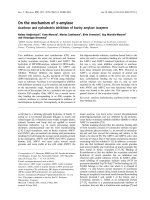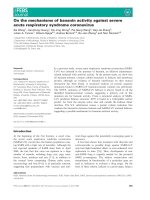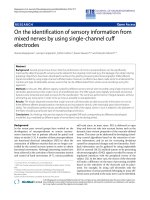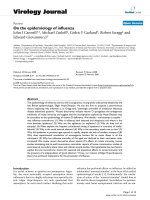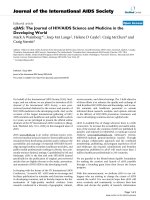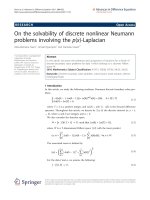Báo cáo hoa học: " On the stability of a mixed type functional equation in generalized functions" ppt
Bạn đang xem bản rút gọn của tài liệu. Xem và tải ngay bản đầy đủ của tài liệu tại đây (192.83 KB, 21 trang )
This Provisional PDF corresponds to the article as it appeared upon acceptance. Fully formatted
PDF and full text (HTML) versions will be made available soon.
On the stability of a mixed type functional equation in generalized functions
Advances in Difference Equations 2012, 2012:16 doi:10.1186/1687-1847-2012-16
Young-Su Lee ()
ISSN 1687-1847
Article type Research
Submission date 18 November 2011
Acceptance date 16 February 2012
Publication date 16 February 2012
Article URL />This peer-reviewed article was published immediately upon acceptance. It can be downloaded,
printed and distributed freely for any purposes (see copyright notice below).
For information about publishing your research in Advances in Difference Equations go to
/>For information about other SpringerOpen publications go to
Advances in Difference
Equations
© 2012 Lee ; licensee Springer.
This is an open access article distributed under the terms of the Creative Commons Attribution License ( />which permits unrestricted use, distribution, and reproduction in any medium, provided the original work is properly cited.
On the stability of a mixed type
functional equation in generalized
functions
Young-Su Lee
Department of Mathematics, Sogang University, Seoul 121-741, Repu blic of Korea
Email address:
Abstract
We reformulate the following mixed type quadratic and additive functional eq ua-
tion with n-independent variables
2f
n
i=1
x
i
+
1≤i,j≤n
i=j
f(x
i
− x
j
) = (n + 1)
n
i=1
f(x
i
) + (n − 1)
n
i=1
f(−x
i
)
as the equation for the spaces of generalized functions. Using the fundamental
solution of the heat equation, we solve the general solution and prove the Hyers–
Ulam stability of this equation in the spaces of tempered distributions and Fourier
hyperfunctions.
Keywords: quadratic functional equation; additive functional equation; stability;
heat kernel; Gauss trans fo rm.
Mathematics Subject Classification 2000: 39B82; 39B52.
1
1. Intro duction
In 1940, Ulam [1] raised a question concerning the stability of group homomorphisms
as follows:
Let G
1
be a group and let G
2
be a metric group with the metric
d(·, ·). Given ǫ > 0, does there exist a δ > 0 such that if a function
h : G
1
→ G
2
satisfies the inequality d(h(xy), h(x)h(y)) < δ for all
x, y ∈ G
1
, then there exists a homomorphism H : G
1
→ G
2
with
d(h(x), H(x)) < ǫ for all x ∈ G
1
?
In 1941, Hyers [2] firstly presented the stability result of functional equations under
the assumption that G
1
and G
2
are Banach spaces. In 1978 , Rassias [3] generalized
Hyers’ result to the unbounded Cauchy difference. After that stability problems
of various functional equations have been extensively studied and generalized by a
number of authors (see [4–7]). Among them, Towanlong and Nakmahachalasint [8]
introduced the following functional equation with n-independent variables
2f
n
i=1
x
i
+
1≤i,j≤n
i=j
f(x
i
− x
j
) = (n + 1)
n
i=1
f(x
i
) + (n − 1)
n
i=1
f(−x
i
),(1.1)
where n is a positive integer with n ≥ 2. For real vector spaces X and Y , they
proved that a function f : X → Y satisfies (1.1) if and only if there exist a quadratic
function q : X → Y satisfying
q(x + y) + q(x − y) = 2q(x) + 2q(y)
and an additive function a : X → Y satisfying
a(x + y) = a(x) + a(y)
such that
f(x) = q(x) + a(x)
for all x ∈ X. For this reason, equation (1.1 ) is called the mixed type quadratic
and additive functional equation. We refer to [9–14] for the stability results of other
mixed type f unctional equations.
In this article, we consider equation (1.1) in the spaces of generalized functions
such as the space S
′
(R) of tempered distributions and the space F
′
(R) of Fourier hy-
perfunctions. Making use of similar approaches in [15–20], we reformulate equation
(1.1) a nd the related inequality for the spaces of generalized functions as follows:
2u ◦ A +
1≤i,j≤n,
i=j
u ◦ B
ij
= (n + 1)
n
i=1
u ◦ P
i
+ (n − 1)
n
i=1
u ◦ Q
i
,(1.2)
2u ◦ A +
1≤i,j≤n,
i=j
u ◦ B
ij
− (n + 1)
n
i=1
u ◦ P
i
− (n − 1)
n
i=1
u ◦ Q
i
≤ ǫ,(1.3)
where A, B
ij
, P
i
and Q
i
are the functions defined by
A(x
1
, . . . , x
n
) = x
1
+ · · · + x
n
,
B
ij
(x
1
, . . . , x
n
) = x
i
− x
j
, 1 ≤ i, j ≤ n, i = j,
P
i
(x
1
, . . . , x
n
) = x
i
, 1 ≤ i ≤ n,
Q
i
(x
1
, . . . , x
n
) = −x
i
, 1 ≤ i ≤ n.
Here ◦ denotes the pullback of generalized functions a nd the inequality v ≤ ǫ in
(1.3) means that |v, ϕ| ≤ ǫϕ
L
1
for a ll test functions ϕ.
In order to solve the general solution of (1.2) and prove the Hyers–Ulam stability
of (1.3), we employ the heat kernel method stated in section 2. In section 3, we
prove that every solution u in F
′
(R) (or S
′
(R), resp.) of equation (1.2) is of the
form
u = ax
2
+ bx
for some a, b ∈ C. Subsequently, in section 4, we prove that every solution u in
F
′
(R) (or S
′
(R), resp.) of the inequality (1.3) can be written uniquely in the form
u = ax
2
+ bx + µ(x),
where µ is a bounded measurable function such that µ
L
∞
≤
n
2
+n−3
n
2
+n−2
ǫ.
2. Preliminaries
In this section, we introduce the spaces of tempered distributions and Fourier hy-
perfunctions. We first consider the space of ra pidly decreasing functions which is a
test function space of tempered distributions.
Definition 2.1. [21] The space S(R) denotes the set of all infinitely differentiable
functions ϕ : R → C such that
ϕ
α,β
= sup
x
|x
α
D
β
ϕ(x)| < ∞
for all nonnegative integers α, β.
In other words, ϕ(x) as well as its derivatives of all orders vanish at infinity faster
than the reciprocal o f any polynomial. For that reason, we call the element of
S(R) as the rapidly decreasing function. It can be easily shown that the function
ϕ(x) = exp(−ax
2
), a > 0, belongs to S(R), but ψ(x) = (1 + x
2
)
−1
is not a member
of S(R). Next we consider the space of tempered distributions which is a dual space
of S(R).
Definition 2.2. [21] A linear functional u on S(R) is said to be a tempered distri-
bution if there exi sts constant C ≥ 0 and nonnegative integer N such that
|u, ϕ| ≤ C
α,β≤N
sup
x
|x
α
D
β
ϕ|(2.1)
for all ϕ ∈ S(R). The s et of all tempered distributions is denoted b y S
′
(R).
For example, every f ∈ L
p
(R), 1 ≤ p < ∞, defines a tempered distribution by
virtue of the relation
f, ϕ =
f(x)ϕ(x)dx, ϕ ∈ S(R).
Note that tempered distributions are g eneralizations of L
p
-functions. These are
very useful for the study of Fourier transforms in generality, since all tempered
distributions have a Fourier transform, but not all distributions have one. Imposing
the growth condition on ·
α,β
in (2.1) a new space of test functions has emerged
as follows.
Definition 2.3. [22] We denote by F(R) the set o f all infinitely differentiable
functions ϕ in R such that
(2.2) ϕ
A,B
= sup
x,α,β
|x
α
D
β
ϕ(x)|
A
|α|
B
|β|
α!β!
< ∞
for some positive constants A, B depending only on ϕ.
It can be verified that t he seminorm (2.2) is equivalent to
ϕ
h,k
= sup
x,α
|D
α
ϕ(x)| exp k|x|
h
|α|
α!
< ∞
for some constants h, k > 0.
Definition 2.4. [22] The strong dual space of F(R) is called the Fourier hyper-
functions. We denote the Fourier hyperfunc tion s by F
′
(R).
It is easy to see the following topological inclusions:
F(R) ֒→ S(R), S
′
(R) ֒→ F
′
(R).(2.3)
Taking the relations (2.3) into account, it suffices to consider the space F
′
(R). In
order to solve the general solution and the stability problem of (1.2) in the space
F
′
(R), we employ the fundamental solution of the heat equation called the heat
kernel,
E
t
(x) = E(x, t) =
(4πt)
−1/2
exp(−x
2
/4t) , x ∈ R, t > 0,
0 , x ∈ R, t ≤ 0.
Since for each t > 0, E(·, t) belongs to the space F(R), the convolution
˜u(x, t) = (u ∗ E)(x, t) = u
y
, E
t
(x − y) , x ∈ R, t > 0
is well defined for all u ∈ F
′
(R). We call ˜u as the G auss transform of u. Semigroup
property of the heat kernel
(E
t
∗ E
s
)(x) = E
t+s
(x)
holds for convolution. It is useful to convert equation (1.2) into the classical func-
tional equation defined on upper-half plane. We also use the following famous result
called heat kernel method, which states as follows.
Theorem 2.5. [23] Let u ∈ S
′
(R). Then its Gauss transform ˜u is a C
∞
-solution
of the heat equation
(∂/∂t − ∆)˜u(x, t) = 0
satisfying
(i) There exist positive constants C, M and N such that
|˜u(x, t)| ≤ Ct
−M
(1 + |x|)
N
in R × (0, δ).(2.4)
(ii) ˜u(x, t) → u as t → 0
+
in the sense that for every ϕ ∈ S(R),
u, ϕ = lim
t→0
+
˜u(x, t)ϕ(x)dx.
Conversely, every C
∞
-solution U(x, t) of the heat equation satisfying the growth
condition (2.4) can be uniquely expressed as U(x, t) = ˜u(x, t) for some u ∈ S
′
(R).
Similarly, we can represent Fourier hyperfunctions as initial values of solutions of
the heat equation as a special case of t he results as in [24 ]. In this case, the condition
(i) in the above theorem is replaced by t he following:
For every ε > 0 there exists a positive constant C
ε
such that
|˜u(x, t)| ≤ C
ε
exp(ε(|x| + 1/t)) in R × (0, δ).
3. General solution in F
′
(R)
We are now going to solve the general solution of (1.2) in the space of F
′
(R) (or
S
′
(R), resp.). In order to do so, we employ the heat kernel mentioned in the previous
section. Convolving the tensor product E
t
1
(x
1
) . . . E
t
n
(x
n
) of the heat kernels on
both sides of (1.2) we have
[(u ◦ A) ∗ (E
t
1
(x
1
) . . . E
t
n
(x
n
))](ξ
1
, . . . , ξ
n
)
= u ◦ A, E
t
1
(ξ
1
− x
1
) . . . E
t
n
(ξ
n
− x
n
)
=
u,
· · ·
E
t
1
(ξ
1
− x
1
+ x
2
+ · · · + x
n
)E
t
2
(ξ
2
− x
2
) . . . E
t
n
(ξ
n
− x
n
) dx
2
. . . dx
n
=
u,
· · ·
E
t
1
(ξ
1
+ · · · + ξ
n
− x
1
− · · · − x
n
)E
t
2
(x
2
) . . . E
t
n
(x
n
) dx
2
. . . dx
n
= u, (E
t
1
∗ . . . ∗ E
t
n
)(ξ
1
+ · · · + ξ
n
− x
1
)
= u, E
t
1
+···+t
n
(ξ
1
+ · · · + ξ
n
)
= ˜u(ξ
1
+ · · · + ξ
n
, t
1
+ · · · + t
n
),
[(u ◦ B
ij
) ∗ (E
t
1
(x
1
) . . . E
t
n
(x
n
))](ξ
1
, . . . , ξ
n
) = ˜u(ξ
i
− ξ
j
, t
i
+ t
j
),
[(u ◦ P
i
) ∗ (E
t
1
(x
1
) . . . E
t
n
(x
n
))](ξ
1
, . . . , ξ
n
) = ˜u(ξ
i
, t
i
),
[(u ◦ Q
i
) ∗ (E
t
1
(x
1
) . . . E
t
n
(x
n
))](ξ
1
, . . . , ξ
n
) = ˜u(−ξ
i
, t
i
),
where ˜u is the Gauss transform of u. Thus, (1.2) is converted into the following
classical functional equation
2˜u
n
i=1
x
i
,
n
i=1
t
i
+
1≤i,j≤n,
i=j
˜u(x
i
− x
j
, t
i
+ t
j
)
= (n + 1)
n
i=1
˜u(x
i
, t
i
) + (n − 1)
n
i=1
˜u(−x
i
, t
i
)
for all x
1
, . . . , x
n
∈ R, t
1
, . . . , t
n
> 0. We here need the f ollowing lemma which will
be crucial role in the proof of main theorem.
Lemma 3.1. A continuous function f : R × (0, ∞) → C satisfi es the functional
equation
2f
n
i=1
x
i
,
n
i=1
t
i
+
1≤i,j≤n
i=j
f(x
i
− x
j
, t
i
+ t
j
)
= (n + 1)
n
i=1
f(x
i
, t
i
) + (n − 1)
n
i=1
f(−x
i
, t
i
)
(3.1)
for all x
1
, . . . , x
n
∈ R, t
1
, . . . , t
n
> 0 if and only if there exist constants a, b, c ∈ C
such that
f(x, t) = ax
2
+ bx + ct
for all x ∈ R, t > 0.
Proof. Putting (x
1
, . . . , x
n
) = (0, . . . , 0) in (3.1) yields
f
0,
n
i=1
t
i
+
1≤i<j≤n
f(0, t
i
+ t
j
) = n
n
i=1
f(0, t
i
)(3.2)
for a ll t
1
, . . . , t
n
> 0. In view of (3.2) we see that
c := lim
t→0
+
f(0, t)
exists. Letting t
1
= · · · = t
n
→ 0
+
in (3.2) gives c = 0. Setting (x
1
, x
2
, x
3
, . . . , x
n
) =
(x, y, 0, . . . , 0) and letting t
1
= t, t
2
= s, t
3
= · · · = t
n
→ 0
+
in (3.1) we have
2f(x + y, t + s) + f(x − y, t + s) + f(−x + y, t + s)
= 3f(x, t) + 3f(y, s) + f(−x, t) + f(−y, s)
(3.3)
for a ll x, y ∈ R, t, s > 0. Replacing x and y with −x and −y in (3.3) yields
2f(−x − y, t + s) + f (−x + y, t + s) + f(x − y, t + s)
= 3f (−x, t) + 3f(−y, s) + f(x, t) + f(y, s)
(3.4)
for all x, y ∈ R, t, s > 0. We now define the even part and the odd part of the
function f by
f
e
(x, t) =
f(x, t) + f(−x, t)
2
, f
o
(x, t) =
f(x, t) − f(−x, t)
2
for a ll x ∈ R, t > 0. Adding (3.3) to (3.4) we verify that f
e
satisfies
f
e
(x + y, t + s) + f
e
(x − y, t + s) = 2f
e
(x, t) + 2f
e
(y, s)(3.5)
for all x, y ∈ R, t, s > 0. Similarly, taking the difference of (3.3) and (3.4) we see
that f
o
satisfies
f
o
(x + y, t + s) = f
o
(x, t) + f
o
(y, s)(3.6)
for all x, y ∈ R, t, s > 0. It follows from (3.5), (3.6) and given the continuity that f
e
and f
o
are of the forms
f
e
(x, t) = ax
2
+ c
1
t, f
o
(x, t) = bx + c
2
t
for some constants a, b, c
1
, c
2
∈ C. Finally we have
f(x, t) = f
e
(x, t) + f
o
(x, t) = ax
2
+ bx + ct,
where c = c
1
+ c
2
.
Conversely, if f (x, t) = ax
2
+ bx + c for some a, b, c ∈ C, then it is obvious that f
satisfies equation (3.1 ).
According to the above lemma, we solve the general solution of (1.2) in the space
of F
′
(R) (or S
′
(R), resp.) as follows.
Theorem 3.2. Every solution u in F
′
(R) (or S
′
(R), resp.) of equation ( 1.2) has
the form
u = ax
2
+ bx,
for some a, b ∈ C.
Proof. Convolving the tensor product E
t
1
(x
1
) . . . E
t
n
(x
n
) of the heat kernels on b oth
sides of (1.2) we have
2˜u
n
i=1
x
i
,
n
i=1
t
i
+
1≤i,j≤n,
i=j
˜u(x
i
− x
j
, t
i
+ t
j
)
= (n + 1)
n
i=1
˜u(x
i
, t
i
) + (n − 1)
n
i=1
˜u(−x
i
, t
i
)
(3.7)
for all x
1
, . . . , x
n
∈ R, t
1
, . . . , t
n
> 0. It follows from Lemma 3.1 that the solution ˜u
of equation (3.7) has the form
˜u(x, t) = ax
2
+ bx + ct(3.8)
for some a, b, c ∈ C. Letting t → 0
+
in (3.8), we finally obtain the general solution
of (1.2).
4. Stability in F
′
(R)
In this section, we are going to state and prove the Hyers–Ulam stability of (1.3) in
the space of F
′
(R) (or S
′
(R), resp.).
Lemma 4.1. Suppose that f : R × (0, ∞) → C is a con tinuous function satisfying
2f
n
i=1
x
i
,
n
i=1
t
i
+
1≤i,j≤n
i=j
f(x
i
− x
j
, t
i
+ t
j
)
− (n + 1)
n
i=1
f(x
i
, t
i
) − (n − 1)
n
i=1
f(−x
i
, t
i
)
≤ ǫ
(4.1)
for all x
1
, . . . , x
n
∈ R, t
1
, . . . , t
n
> 0, then there exists the unique function g : R ×
(0, ∞) → C satisfying equation (3.1) such that
|f(x, t) − g(x, t)| ≤
n
2
+ n − 3
n
2
+ n − 2
ǫ
for all x ∈ R, t > 0.
Proof. Putting (x
1
, . . . , x
n
) = (0, . . . , 0) in (4.1) yields
f
0,
n
i=1
t
i
+
1≤i<j≤n
f(0, t
i
+ t
j
) − n
n
i=1
f(0, t
i
)
≤
ǫ
2
(4.2)
for a ll t
1
, . . . , t
n
> 0. In view of (4.2) we see that
c := lim sup
t→0
+
f(0, t)
exists. Letting t
1
= · · · = t
n
→ 0
+
in (4.2) gives
|c| ≤
ǫ
n
2
+ n − 2
.(4.3)
Setting (x
1
, x
2
, x
3
, . . . , x
n
) = (x, x, 0, . . . , 0) and letting t
1
= t
2
= t, t
3
= · · · = t
n
→
0
+
in (4.1) we have
f(2x, 2t) + f(0, 2t) − 3 f (x, t) − f(−x, t) −
c(n
2
+ n − 6)
2
≤
ǫ
2
(4.4)
for a ll x ∈ R, t > 0. Replacing x by −x in (4.4 ) yields
f(−2x, 2t) + f(0, 2t) − 3f(−x, t) − f(x, t) −
c(n
2
+ n − 6)
2
≤
ǫ
2
(4.5)
for all x ∈ R, t > 0. Let f
e
and f
o
be even and odd part of f defined in Lemma 3.1,
respectively. Using the triangle inequality in (4.4) and (4.5) we get the inequalities
g
e
(2x, 2t)
4
− g
e
(x, t) +
g
e
(0, 2t)
4
≤
ǫ
8
,(4.6)
f
o
(2x, 2t)
2
− f
o
(x, t)
≤
ǫ
4
(4.7)
for a ll x ∈ R, t > 0, where g
e
(x, t) := f
e
(x, t) +
c(n
2
+n−6)
4
.
We first consider the even case. Using the iterative method in (4.6) we obtain
g
e
2
k
x, 2
k
t
4
k
− g
e
(x, t) +
k
j=1
g
e
(0, 2
j
t)
4
j
≤
ǫ
6
(4.8)
for all k ∈ N, x ∈ R, t > 0. Letting t
1
= t, t
2
= s, t
3
= · · · = t
n
→ 0
+
in (4.2) we
have
g
e
(0, t + s) − g
e
(0, t) − g
e
(0, s)
≤
ǫ
4
(4.9)
for a ll t, s > 0. We verify from (4.9 ) that
h(t) := lim
k→∞
g
e
(0, 2
k
t)
2
k
converges and is the unique f unction satisfying
h(t + s) = h(t) + h(s),(4.10 )
|h(t) − g
e
(0, t)| ≤
ǫ
4
(4.11)
for a ll t, s > 0. Combining (4.10) and (4.11) we get
(1 − 2
−k
)h(t) −
k
i=1
g
e
(0, 2
k
t)
4
k
≤
ǫ
12
(4.12)
for a ll k ∈ N, t > 0. Adding (4.8) to ( 4.12) we have
˜g
e
(x, t) −
˜g
e
(2
k
x, 2
k
t)
4
k
≤
ǫ
4
(4.13)
for all k ∈ N, x ∈ R, t > 0, where ˜g
e
(x, t) := g
e
(x, t) − h(t). From (4.1) and (4.13)
we verify that
G
e
(x, t) := lim
k→∞
˜g
e
2
k
x, 2
k
t
4
k
is the unique function satisfying equation (3.1) and the inequality
|˜g
e
(x, t) − G
e
(x, t)| ≤
ǫ
4
(4.14)
for all x ∈ R, t > 0. If we define a function q(x, t) := G
e
(x, t) + h(t), then q also
satisfies (3.1). By Lemma 3.1 and evenness of q we have
q(x, t) = ax
2
+ c
1
t
for some a, c
1
∈ C. It follows from (4.3) and (4.14) that
|f
e
(x, t) − ax
2
− c
1
t| ≤
n
2
+ n − 4
2(n
2
+ n − 2)
ǫ(4.15)
for a ll x ∈ R, t > 0.
Next, we consider the odd case. From (4.7), in the similar manner, we verify that
F
o
(x, t) := lim
k→∞
f
o
(2
k
x, 2
k
t)
2
k
is the unique function satisfying equation (3.1) and the inequality
|F
o
(x, t) − f
o
(x, t)| ≤
ǫ
2
(4.16)
for a ll x ∈ R, t > 0. By Lemma 3.1 and oddness of F
o
we have
F
o
(x, t) = bx + c
2
t
for some b, c
2
∈ C.
Therefore, from (4.15) and (4.16), we obtain
|f(x, t) − (ax
2
+ bx + ct)|
≤ |f
e
(x, t) − (ax
2
+ c
1
t)| + |f
o
(x, t) − (bx + c
2
t)|
≤
n
2
+ n − 3
n
2
+ n − 2
ǫ
for a ll x ∈ R, t > 0, where c = c
1
+ c
2
.
From the above lemma we immediately prove the Hyers–Ulam stability of (1.3)
in the space of F
′
(R) (or S
′
(R), resp.) as follows.
Theorem 4.2. Suppose that u in F
′
(R) (or S
′
(R), resp.) satisfies the inequality
(1.3), then there exists the unique q uad ratic additive function q(x) = ax
2
+ bx such
that
u − q(x) ≤
n
2
+ n − 3
n
2
+ n − 2
ǫ.(4.17)
Proof. Convolving the tensor product E
t
1
(x
1
) . . . E
t
n
(x
n
) of the heat kernels on b oth
sides of (1.3) we verify that t he inequality ( 1.3) is converted into
2˜u
n
i=1
x
i
,
n
i=1
t
i
+
1≤i,j≤n
i=j
˜u(x
i
− x
j
, t
i
+ t
j
)
− (n + 1)
n
i=1
˜u(x
i
, t
i
) − (n − 1)
n
i=1
˜u(−x
i
, t
i
)
≤ ǫ
for all x
1
, . . . , x
n
∈ R, t
1
, . . . , t
n
> 0. According to Lemma 4 .1 , there exists the
unique function g(x, t) = ax
2
+ bx + ct such that
|˜u(x, t) − g(x, t)| ≤
n
2
+ n − 3
n
2
+ n − 2
ǫ(4.18)
for all x ∈ R, t > 0. Letting t → 0
+
in (4.18) finally we have the stability result
(4.17).
Remark 4.3. The a bove norm inequality u − q(x) ≤
n
2
+n−3
n
2
+n−2
ǫ implies that u − q(x)
belongs to (L
1
)
′
= L
∞
. Thus, every solution u of the inequality (4.17) in F
′
(R) (or
S
′
(R), resp.) can be rewritten uniquely in the form
u = q(x) + µ(x),
where µ is a bounded measurable function such that µ
L
∞
≤
n
2
+n−3
n
2
+n−2
ǫ.
Competing interests
The author declares that he has no competing interests.
References
[1] Ulam, SM: Problems in Modern Mathematics. Wiley, New Yo rk (1964)
[2] Hyers, DH: On the stability of the linear functional equation. Proc. Natl Acad. Sci. USA 27,
222–224 (1941)
[3] Rassias, ThM: On the stability of the linear mapping in Banach spaces. Proc. Am. Math. Soc.
72, 297–300 (1978)
[4] Czerwik, S: Functional Equations and Inequalities in Several Variables. World Scientific Pub-
lishing Co., Inc., River Edge (2002 )
[5] Hyers, DH, Isac, G, Rassias, ThM: Stability of Functional Equations in Several Variables.
Birkh¨auser, Boston (1998)
[6] Jung, S-M: Hyers–Ulam–Rassias Stability of Functional Equations in Nonlinear Analysis.
Springer Optimization and Its Applications. Spring e r, New York (2011)
[7] Kannappan, Pl: Functional Equations and Inequalities with Applications. Springer, New Yo rk
(2009)
[8] Towanlong, W, Nakmahachalasint, P: An n-dimensional mixed- type additive and quadratic
functional equation and its stability. Science Asia 35, 381–385 (2009)
[9] Eshaghi Gordji, M, Savadkouhi, MB: Stability of mixed type c ubic and quartic functional
equations in random normed spaces. J. Inequal. Appl. 2009(Article ID 527462), 9 (2009)
[10] Eshaghi Gordji, M, Kaboli Gharetapeh, S, Moslehian MS, Zolfaghari, S: Stability of a Mixed
Type Additive, Q uadratic, Cubic and Quartic Functional Equation. Nonlinear Analysis and
Variational Problems, vol. 35, pp. 65–80. Springer Optimization and Its Applications. Springer,
New York (2010)
[11] Jun, K-W, K im, H-M: On the stability of an n-dimensional quadratic and additive functional
equation. Math. Inequal. Appl. 9, 153–165 (2006)
[12] Kannappan, Pl, Sahoo, PK: On generalizations of the Pompeiu functional equation. Int. J.
Math. Math. Sci. 21, 117–124 (1998)
[13] Najati, A, Eskandani, GZ: A fixed point method to the generalized stability of a mixed additive
and quadratic functional equation in Banach modules. J. Diff. Equ. Appl. 16, 773–788 (2010)
[14] Wang, L, Liu, B, Bai, R: Stability of a mixed type functional equation on multi-Banach spaces:
a fixed point approach. Fixed Point Theory Appl. 2010(Article ID 283827), 9 (201 0)
[15] Chung, J: Stability of functional equations in the spaces of distributions and hyperfunctions.
J. Math. Anal. Appl. 286, 177–186 (2003)
[16] Chung, J, Lee, S: Some functional equations in the spaces of generalized functions. Aequa tiones
Math. 65, 267–279 (2003)
[17] Chung, J, Chung, S-Y, Kim, D: The stability of Cauchy equations in the space of Schwartz
distributions. J. Math. Anal. Appl. 295, 107–114 (2004)
[18] Lee, Y-S: Stability of a quadratic functional equation in the spaces of generalized functions.
J. Inequal. Appl. 2008(Article ID 210615), 12 (2008)
[19] Lee, Y-S, Chung, S-Y: The stability of a general quadratic functional equation in distributions.
Publ. Math. Debrecen 74, 293–306 (2009)
[20] Lee, Y-S, Chung, S-Y: Stability of quartic functional equations in the spaces of generalized
functions. Adv. Diff. 2009(Article ID 83 8347), 16 (2009)
[21] Schwartz, L: Th´eorie des Distributions. Hermann, Paris (1966)
[22] Chung, J, Chung S-Y, Kim, D: A characterization for Fourier hyperfunctions. Publ. Res. Inst.
Math. Sci. 30, 203–208 (1994)
[23] Matsuzawa, T: A calculus approach to hyperfunctions III. Nagoya Math. J. 118, 133– 153
(1990)
[24] Kim, KW, Chung S-Y, Kim, D: Fourier hyperfunctions as the boundary values of smooth
solutions of heat equations. Publ. Res. Inst. Math. Sci. 29, 289–300 (1993)
